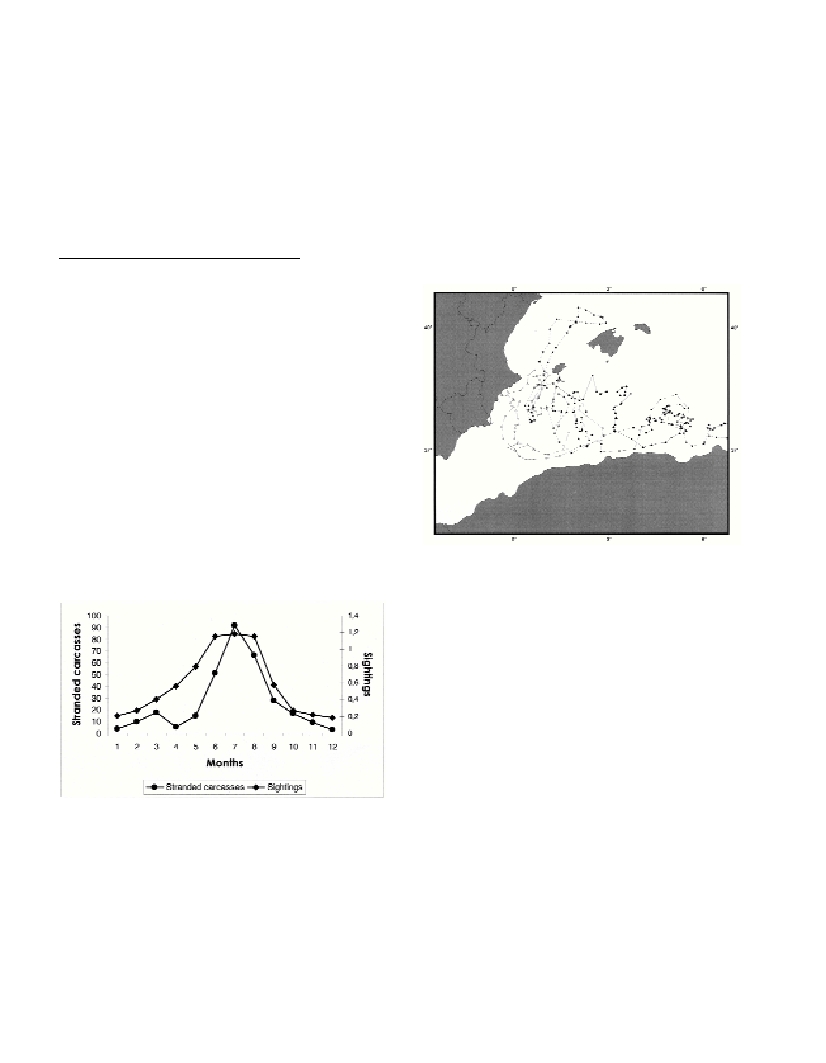DO MEDITERRANEAN IMMATURE LOGGERHEAD TURTLES MIGRATE SEASONALLY?
CONTRASTING EVIDENCE FROM STRANDED SPECIMENS, FISHERMEN AND SATELLITE TRACKING
Cardona L.
1
, Revelles M.
1
, Carreras C.
1
*, San Felix M.
2
, Fernández G.
3
, Aguilar A.
1
1
Department of Animal Biology, Faculty of Biology, University of Barcelona, Spain
2
Department of Zoology, Faculty of Biology, University of Valencia, Burjasot, Spain
3
Fundación Marineland, Costa d’en Blanes-Calvià, Spain
Abstract
We studied the existence of a northward spring migration of immature loggerhead turtles in the Balearic archipelago. Fishermen claimed
that loggerhead turtles are more often observed in summer, when the annual peak for stranded turtles was also recorded. However, none
of the five turtles tracked by satellite from April 2003 to July 2003 migrated northwards. This suggested that turtles do not migrate
northwards in spring. Reported seasonal patterns of sightings and strandings might re?ect an increase in mortality rate due to the incidental
catches produced by fishing.
Keywords: Caretta caretta, migration, telemetry
Rapp. Comm. int. Mer Médit., 37,2004
327
Immature loggerhead turtles (Caretta caretta) inhabiting cool-
temperate areas usually migrate seasonally (1) to avoid cold-stunning
at temperatures lower than 12 ºC (2). Around the Balearic Islands,
immature loggerhead turtles occur year round (3), but in the northern
islands they have been claimed to migrate southward in winter.
We investigated the existence of a latitudinal migration using three
methods: (i) recording the seasonal number of carcasses stranded in
the archipelago from 1998 to 2002; (ii) conducting in 2002 (May-
August) a questionnaire-based survey that included questions about
monthly variation in sightings; and (iii) deploying in early April 2003
Telonics ST-18 satellite transmitters (4) on five immature loggerhead
turtles (average Straight Carapace Length: 41.36 cm; range 37.1-
48.7cm) collected off Formentera island. Position data were received
and processed by the Argos Service (5). Turtles were tracked till late
July. The Rayleigh test (6) was used for testing the existence of a
preferred direction.
Fishermen stated that loggerhead turtles were more often observed
during summer, when the annual peak for stranded individuals also
occurred (Fig. 1). However, none of the five tracked turtles exhibited
a consistent northward migration (Fig. 2) and the Rayleigh test did not
identify any preferred direction for any of the animals (turtle A, z=1.8
p>0.05; turtle B, z=2.4 p>0.05; turtle C, z=2.2 p>0.05; turtle D, z:1.2
p>0.05; turtle E, z: 2.8 p>0.05).
Fig. 1. Seasonal variation in sightings made by professional fishermen
(left) and occurrence of stranded turtles (right).
These results suggest that immature loggerhead turtles did not
migrate northward in spring. The reported summer increase in
sightings and strandings is likely to be the result of the seasonal
increase in mortality caused by fishing gears used only during the
summer (3, 7). A further element affecting fishermen perception
towards turtle abundance is likely to be the fact that these latter fishing
gears are set and hauled during light hours, whereas those used in
autumn and winter are set and hauled at night, when turtle sightings
are unlikely. It is thus concluded that both information from fishermen
and seasonal variation in number of stranded animals cannot be used
to infer turtle migration or abundance.
Fig. 2. Tracks followed by the five tagged turtles (early April to late July,
2003) within the Algerian basin.
References
1-Musick J.A., Limpus C., 1997. Habitat utilization and migration in
juvenile sea turtles. Pp. 137-163. In:Lutz P.L. and Musick J.A (eds.), The
biology of sea turtles. CRC, Boca Raton.
2-Lutz P.L., Bergey A., Bergey M., 1989. Effects of temperature on gas
exchange and acid-base balance in the sea turtle Caretta carettaat rest and
during routine activity. J. Exp. Biol., 144: 155-169.
3-Camiñas J.A., de la Serna J.M., 1995. The Loggerhead distribution in
the Western Mediterranean Sea as deduced from captures by the Spanish
Long Line Fishery. Pp. 316-323. In:Llorente G., Montori A., Santos X.,
and Carretero M. (eds.), Scientia Herpetologica. Asociación Herpetológica
Española, Barcelona.
4-Balazs G., Miya R., Beavers, S., 1996. Procedures to attach a satellite
transmitter to the carapace of an adult green turtle, Chelonia mydas. Pp.
21-26. In:Keinath J., Barnard D., Musick J., and Bell B. (eds.).
Proceedings of the 15
th
Annual Symposium on Sea Turtle Biology and
Conservation. 1995. National Atmospheric and Oceanic Administration
Tech. Memo. NMFS-SEFSC-367.
5-Argos, 2000. User’s manual. CLS, Ramonville.
6-Zar J.H., 1984. Biostatistical Análisis. Prentice-Hall, Englewood
Cliffs.
7-Carreras C., Cardona L., and Aguilar A., In press. Incidental catch of
the loggerhead turtle Caretta carettaoff the Balearic Islands (western
Mediterranean). Biol. Conserv.

